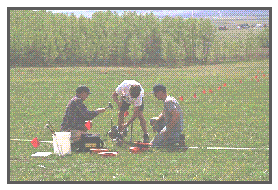DC Resistivity Equipment
 Compared to the equipment required for
gravity surveying and
magnetic surveying, that
required for DC resistivity surveying is much less exotic.
In fact, it is rather mundane consisting of nothing more than a source of electrical current,
an ammeter, a voltmeter, some cable, and electrodes.
Given the nature of the measurements that we are making, however, there are some
considerations that must be taken into account given the equipment used to perform the measurements.
Compared to the equipment required for
gravity surveying and
magnetic surveying, that
required for DC resistivity surveying is much less exotic.
In fact, it is rather mundane consisting of nothing more than a source of electrical current,
an ammeter, a voltmeter, some cable, and electrodes.
Given the nature of the measurements that we are making, however, there are some
considerations that must be taken into account given the equipment used to perform the measurements.
- Current Source - A source of DC current is required.
In general, batteries are not capable of producing the DC currents required, so that if
a pure DC source is used, it has to be produced by a portable electric generator.
If, as is commonly done to eliminate the effects of electrode potentials and
telluric currents, a slowly varying AC current is used, portable, battery
driven sources can be employed for DC resistivity surveys commonly used in engineering and environmental
applications.
- Ammeter - A simple ammeter (a device for measuring electrical current) can be used.
The only constraint is that the meter be capable of measuring amperage from a few milliamps to
about 0.5 amps.
Many of the modern instruments are regulated such that the user determines the amperage input into
the ground and the instrument attempts to deliver it.
If the instrument can not deliver the specified amperage, either because the subsurface is too
resistive or the electrodes are too far apart, the instrument warns the user.
- Voltmeter - A simple voltmeter can also be used.
To avoid problems with contact potential, a voltmeter with a very high
impedance, above 500,000 Ohms, should be used.
The voltmeter must also be capable of measuring voltages from a few millivolts to a few volts.
- Electrodes - To avoid problems associated with electrode potentials,
sophisticated electrodes known as porous pots can be used.
But, because spurious electrode potentials can be mitigated through the use of a slowly varying AC source,
these electrodes are not commonly used for DC resistivity measurements.
If the conditions in the survey are extremely dry and contact between the electrode and the ground can
not be maintained, one might consider using porous pots.
For DC resistivity surveys, the most commonly used electrodes are nothing more than aluminum, copper, or
steel rods about two feet in length. These rods are driven into the ground and connected with cables to
the current source or the voltmeter.
Under dry conditions, contact between the rod and the ground can be enhanced by wetting the ground surrounding
the electrode.
- Cables - To connect the electrodes to the various electrical components, cables must be employed.
These cables are typically nothing more than insulated wires with stranded, copper-cored conductors.
Although long cable lengths may need to be employed, given the high resistivity of the ground, resistance in the
cables is typically negligable.
A more significant problem is current induction in the cables used to make the voltage
measurement from the current flowing in the cables going to the current electrodes.
This source of noise is easily avoidable by simply keeping the voltage cables at a distance (a few feet) from
the current cables.
For easy deployment, cables are usually stored on reels.

 Compared to the equipment required for
gravity surveying and
magnetic surveying, that
required for DC resistivity surveying is much less exotic.
In fact, it is rather mundane consisting of nothing more than a source of electrical current,
an ammeter, a voltmeter, some cable, and electrodes.
Given the nature of the measurements that we are making, however, there are some
considerations that must be taken into account given the equipment used to perform the measurements.
Compared to the equipment required for
gravity surveying and
magnetic surveying, that
required for DC resistivity surveying is much less exotic.
In fact, it is rather mundane consisting of nothing more than a source of electrical current,
an ammeter, a voltmeter, some cable, and electrodes.
Given the nature of the measurements that we are making, however, there are some
considerations that must be taken into account given the equipment used to perform the measurements.
